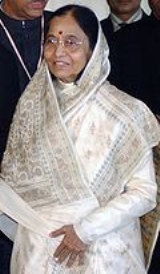
President of India
Overview
Head of State
A head of state is the individual that serves as the chief public representative of a monarchy, republic, federation, commonwealth or other kind of state. His or her role generally includes legitimizing the state and exercising the political powers, functions, and duties granted to the head of...
and first citizen of India
India
India , officially the Republic of India , is a country in South Asia. It is the seventh-largest country by geographical area, the second-most populous country with over 1.2 billion people, and the most populous democracy in the world...
, as well as the Supreme Commander
Supreme Commander
Supreme Commander may refer to:* Commander-in-chief, a military rank**Supreme Allied Commander, title held by the most senior commander within certain multinational military alliances...
of the Indian Armed Forces. President of India is also the formal head of all the three branches of Indian Democracy - Legislature, Executive and Judiciary. Powers to pardon and clemency vests with the President of India.
Although Article 53 of the Constitution
Constitution
A constitution is a set of fundamental principles or established precedents according to which a state or other organization is governed. These rules together make up, i.e. constitute, what the entity is...
states that the President can exercise their powers directly, with few exceptions, all of the authority vested in the President is in practice exercised by the Council of Ministers
Indian Cabinet Ministers
The Cabinet of India is the collective decision-making body of the Government of India, composed of the Prime Minister and 35 Cabinet Ministers, the most senior of the government ministers...
, headed by the Prime Minister
Prime Minister of India
The Prime Minister of India , as addressed to in the Constitution of India — Prime Minister for the Union, is the chief of government, head of the Council of Ministers and the leader of the majority party in parliament...
.
The President is elected, from a group of nominees, by the elected members of the Parliament of India
Parliament of India
The Parliament of India is the supreme legislative body in India. Founded in 1919, the Parliament alone possesses legislative supremacy and thereby ultimate power over all political bodies in India. The Parliament of India comprises the President and the two Houses, Lok Sabha and Rajya Sabha...
(Lok Sabha
Lok Sabha
The Lok Sabha or House of the People is the lower house of the Parliament of India. Members of the Lok Sabha are elected by direct election under universal adult suffrage. As of 2009, there have been fifteen Lok Sabhas elected by the people of India...
and Rajya Sabha
Rajya Sabha
The Rajya Sabha or Council of States is the upper house of the Parliament of India. Rajya means "state," and Sabha means "assembly hall" in Sanskrit. Membership is limited to 250 members, 12 of whom are chosen by the President of India for their expertise in specific fields of art, literature,...
) as well as of the state
States and territories of India
India is a federal union of states comprising twenty-eight states and seven union territories. The states and territories are further subdivided into districts and so on.-List of states and territories:...
legislature
Legislature
A legislature is a kind of deliberative assembly with the power to pass, amend, and repeal laws. The law created by a legislature is called legislation or statutory law. In addition to enacting laws, legislatures usually have exclusive authority to raise or lower taxes and adopt the budget and...
s (Vidhan Sabha
Vidhan Sabha
The Vidhan Sabha or the Legislative Assembly is the lower house or the sole house of the provincial legislature in the different states of India. The same name is also used for the lower house of the legislatures for two of the union territories, Delhi and Pondicherry...
s), and serves for a term of five years.
Discussions

